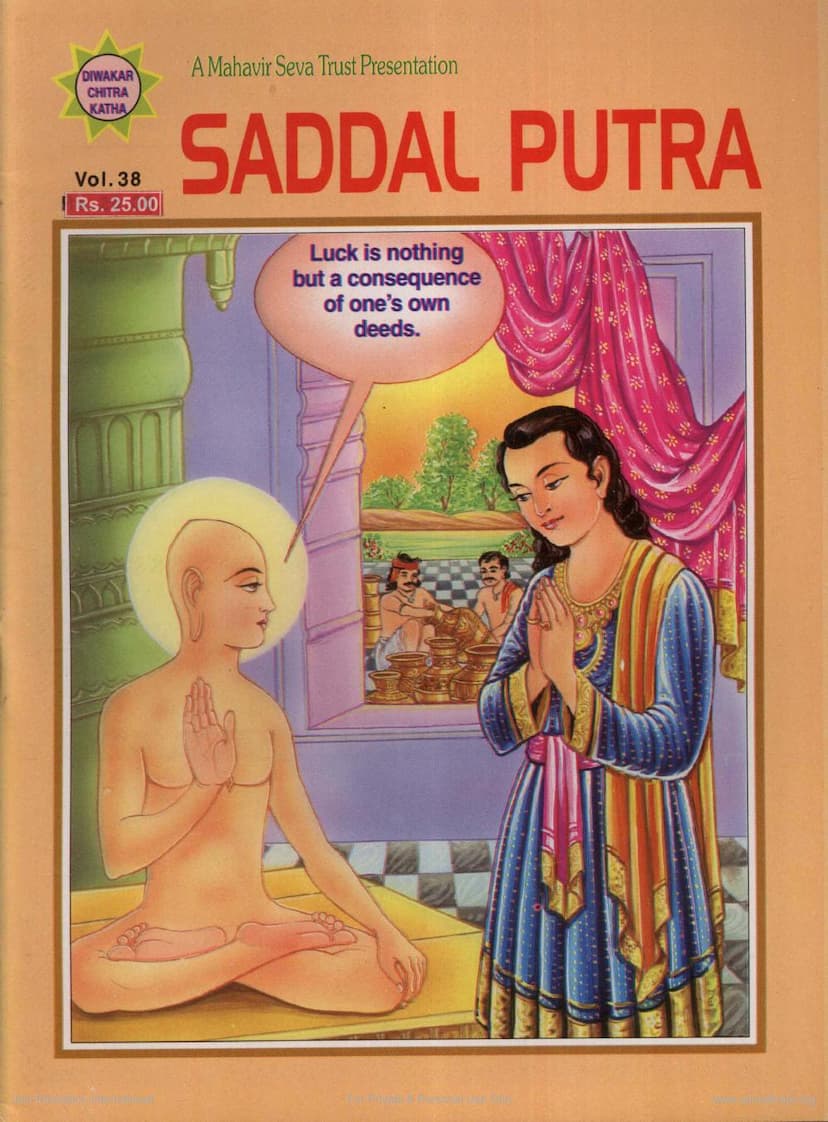Saddal Putra Diwakar Chitrakatha 038
Added to library: September 2, 2025
Loading image...

Summary
This document is a Jain comic book, specifically "Saddal Putra Diwakar Chitrakatha 038," published by Mahavir Seva Trust Mumbai. The central theme is the story of Saddal Putra, a disciple of Lord Mahavir, and the book also includes a second story about Vijay Kumar and Vijaya.
Part 1: Saddal Putra
- Introduction: Saddal Putra was a prominent and prosperous artisan trader, involved in manufacturing and selling artistic earthen pots, agriculture, and cattle business. He was initially a follower of Mankhaliputra Gaushalak and his doctrine of Niyativaad (fatalism), which states that everything happens according to fate and humans are mere puppets.
- Encounter with Mahavir: Bhagavan Mahavir preached the doctrine of karma and endeavor, emphasizing that individuals are responsible for their actions and their consequences. Mahavir explained this with practical logic, which led Saddal Putra to question his belief in fatalism.
- The Test of Faith: Despite Gaushalak's attempts to sway him and tests by gods, Saddal Putra's faith in Mahavir's teachings deepened.
- The Narrative:
- Saddal Putra is depicted as a wealthy potter with vast business operations and a large dairy.
- Townsfolk discuss his immense wealth and attribute it to his guru Gaushalak and his adherence to fatalism.
- A god appears and predicts the arrival of a "Mahamahan" (great Brahmin), omniscient and all-seeing Jina, in Polaspur. Saddal Putra, a follower of Gaushalak, believes this refers to his guru.
- However, the next day, Bhagavan Mahavir arrives. Saddal Putra is initially confused, wondering if the prophecy was wrong. He then decides to attend Mahavir's sermon.
- During the sermon, Mahavir emphasizes that present circumstances are consequences of past deeds and that endeavors shape one's destiny.
- Mahavir asks Saddal Putra how his pots are made. Saddal Putra explains the detailed process involving clay, shaping, and firing.
- Mahavir then uses this explanation to challenge fatalism. He asks if the pots are made through endeavor or automatically. When Saddal Putra admits they are made through effort, Mahavir poses hypothetical scenarios: if someone steals or breaks the pots, who is responsible? Saddal Putra states he would punish the offender, contradicting the idea that everything is fate and no endeavor is needed.
- Mahavir further illustrates that if fate dictates everything, then endeavor and diligence become meaningless. Saddal Putra realizes the practical limitations of fatalism and accepts the importance of endeavor.
- Saddal Putra embraces Mahavir's teachings, accepting the vows of a Shravak (householder), including principles like non-violence, truthfulness, and controlling desires. His wife, Agnimitra, also accepts the teachings.
- Gaushalak's Attempt to Reconvert: Gaushalak, hearing of Saddal Putra's change of heart, visits him. Saddal Putra respectfully explains that Mahavir, as an omniscient, has opened his inner eyes and he cannot be misled by fatalism.
- Spiritual Retirement and Austerities: After fourteen years as a householder, Saddal Putra, realizing his business activities were hindering his spiritual progress, decides to retire and dedicate himself fully to religious practices. He takes the Paushadh vow (a type of fasting and religious observance).
- Divine Tests: A god appears and tries to break Saddal Putra's resolve by creating illusions of his sons being killed and threatening his wife. Saddal Putra remains steadfast, his faith unshaken. However, when the god threatens his wife, Saddal Putra reacts, rushing to catch the illusory attacker.
- Atonement and Realization: Saddal Putra realizes that his reaction to the threat against his wife caused him to break his Paushadh vow. He performs Pratikraman (atonement) and accepts specific austerities.
- Attainment of Heavenly Life: Saddal Putra successfully observes the Shravak Pratimas (higher practices for householders) and, at the end of his life, takes a final vow, leading to his rebirth as a god in the Saudharma dimension.
- The Lesson: The story of Saddal Putra teaches the importance of endeavor over fate. It highlights that individuals are responsible for their happiness and misery and should not be deterred by hardships.
Part 2: Vijay Kumar and Vijaya
- The Vow of Celibacy: Vijay Kumar, a wealthy merchant's son, is inspired by the glory of celibacy and vows to observe it during the dark fortnight of every month.
- Marriage and a Test of Resolve: He marries Vijaya, a beautiful woman. On their wedding night, Vijaya, unaware of his specific vow, is shocked when Vijay abstains from intimacy due to the dark fortnight.
- Mutual Vows: Vijaya reveals that she too has taken a vow of celibacy, but for the bright half of each month. This means they can never be together as husband and wife.
- Shared Resolve: Instead of separating, Vijay proposes that they uphold their individual vows and live together in their mansion, observing complete celibacy. They decide to live like brother and sister, with a sword placed between them on the bed as a symbolic boundary.
- The Revelation and Renunciation: A devoted follower named Jinadas, inspired by a dream and the teachings of Vimal Kevali, learns of their strict celibacy. He recognizes their practice as equivalent to feeding 84,000 ascetics. Jinadas offers them food, revealing their secret. This fulfillment of his desire marks the moment for Vijay and Vijaya to renounce their worldly life.
- Initiation and Liberation: Vijay and Vijaya receive permission from their parents and are initiated as ascetics by Vimal Kevali. They eventually shed all karma and attain liberation.
- The Lesson: This story emphasizes that a pure heart and strong resolve can lead to an unblemished life, even as a householder, and inspires a pious way of life.
Overall Publisher's Note: The document concludes with promotional information about other "Diwakar Chitrakatha" titles, highlighting their role in educating children and adults about Jain culture, history, and way of life through entertaining and informative picture books.